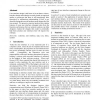Free Online Productivity Tools
i2Speak
i2Symbol
i2OCR
iTex2Img
iWeb2Print
iWeb2Shot
i2Type
iPdf2Split
iPdf2Merge
i2Bopomofo
i2Arabic
i2Style
i2Image
i2PDF
iLatex2Rtf
Sci2ools
AUIC
2005
IEEE
2005
IEEE
The Semiotics of User Interface Redesign
User interface design is still more of an art than a science. Interface design and redesign is mostly based on empirical studies or prototypes but there is still surprisingly little theoretical or engineering understanding of how to go about the design process and produce good designs the first time around. We present a semiotic analysis that explains features of some user interface redesigns taken from the literature and propose that our semiotic analysis can help designers explain the changes they make to potentially help them produce user interfaces that will require less redesign.
| Added | 24 Jun 2010 |
| Updated | 24 Jun 2010 |
| Type | Conference |
| Year | 2005 |
| Where | AUIC |
| Authors | Jennifer Ferreira, Pippin Barr, James Noble |
Comments (0)

